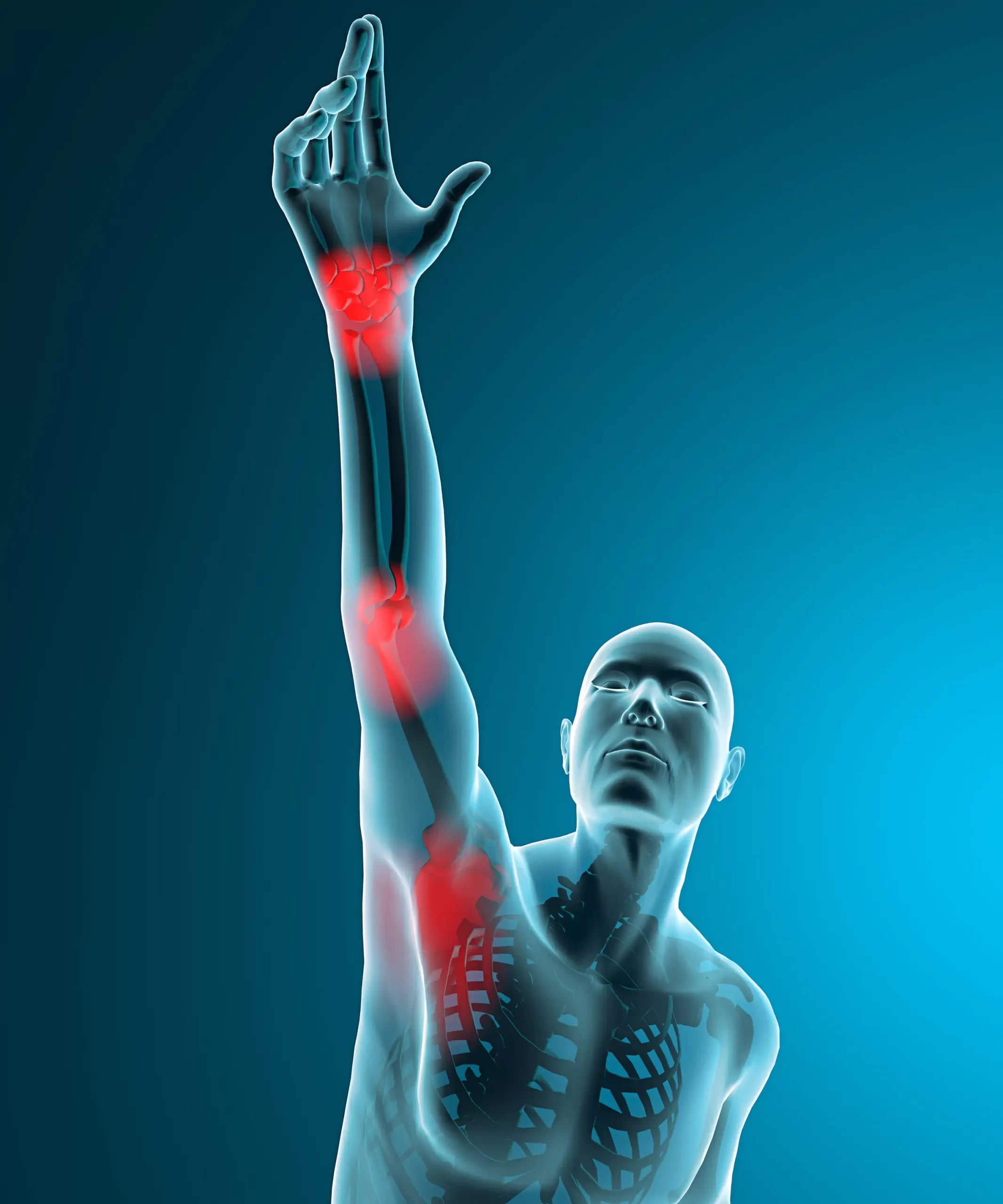What Is Thoracic Outlet Syndrome (TOS)?
Thoracic outlet is used to describe the space between the collarbone and first rib. This space may be damaged or narrowed due to accident, pregnancy or congenital developmental differences. This causes pressure on the nerves and blood vessels passing through the area, causing pain and numbness in the arm on the involved side.
Thoracic outlet syndrome may occur at any age. It can be seen more commonly in athletes who require repetition of arm and shoulder movements such as swimming, tennis, volleyball, compared to the general population.
If you are looking for reliable treatment for thoracic outlet syndrome, contact us now!
What Are Causes of Thoracic Outlet Syndrome?
Thoracic outlet syndrome can be defined as a disease consisting of a series of symptoms affecting the shoulder, arm or hand due to pressure on the nerves and blood vessels in the upper chest area.
The causes of thoracic outlet syndrome can be listed as follows;
- Due to back injury
- Due to posture disorders
- Due to sleep disturbance
- Due to repetitive movements (Typing, using a mouse, etc.)
- Occurrence of neck, collarbone or rib trauma
- Professional practice of sports such as volleyball, tennis, golf, swimming
- Also can occur with tumor or enlarged lymph nodes in the upper chest or armpit.
What Are Symptoms of Thoracic Outlet Syndrome?
The most common thoracic outlet syndrome symptom is pain or numbness in the shoulders, arms, hands and fingers . Other thoracic outlet syndrome symptoms can be listed as follows;
- Neck pain
- Limitation of movement
- Situations such as loss of feeling
- Thoracic outlet syndrome swelling, arm pain, or unusual redness
- Cyanosis (bluish discoloration of the skin)
- Weakness in the neck, arm or hand during gripping
How To Diagnose Thoracic Outlet Syndrome?
Diagnosing TOS can be challenging, as the symptoms can be similar to those of other conditions. Here’s what you need to know about diagnosing thoracic outlet syndrome:
- One of the first steps in diagnosing TOS is taking a detailed medical history and performing a physical exam.
- Imaging tests can help diagnose TOS and determine the underlying cause of the condition. These tests may include X-rays, MRI, and computerized tomography (CT) scan.
- Nerve tests, also known as electromyography (EMG) and nerve conduction studies, can help diagnose TOS by evaluating the function of your nerves.
- Vascular tests, such as an angiogram or ultrasound, can help diagnose TOS by evaluating the blood flow in the affected area.
What Are the Different Types of Thoracic Outlet Syndrome?
There are three main types of TOS, each with its own unique set of TOS symptoms and causes:
Neurogenic Thoracic Outlet Syndrome: This type of TOS symptom occurs when the nerves that pass through the thoracic outlet become compressed or irritated. Neurogenic thoracic outlet syndrome symptoms can include pain, numbness, and weakness in the shoulder, arm, and hand, as well as headaches and neck pain. Neurogenic TOS is the most common type of TOS, accounting for up to 95% of cases.
Venous Thoracic Outlet Syndrome: This type of TOS symptom occurs when the veins that pass through the thoracic outlet become compressed or blocked, preventing blood from flowing properly. Venous thoracic outlet syndrome symptoms can include thoracic outlet syndrome swelling, pain, and discoloration in the arm and hand, as well as a feeling of heaviness or fatigue.
Arterial Thoracic Outlet Syndrome: This type of TOS symptom occurs when the arteries that pass through the thoracic outlet become compressed or blocked, preventing blood from flowing properly. Arterial thoracic outlet syndrome symptoms can include pain, numbness, and coldness in the arm and hand, as well as weakness and fatigue.
How Do You Fix Thoracic Outlet Syndrome?
Early diagnosed problems can be treated with physical therapy and pain medication. Some patients may achieve positive results in the thoracic outlet syndrome treatment
of the disease with lifestyle changes such as weight loss, regular nutrition, and sports.
Surgical methods are preferred in patients in whom these treatment methods are not effective, who are at risk of developing nerve damage, or in patients where the syndrome is caused by an anatomical defect in the bones.
Surgical treatment, like the one offered by MD. Burak, of thoracic outlet syndrome is carried out with different methods, such as removing the first rib, loosening the muscles and tendons that cause compression in the region, in order to address the source of the problem.
Can Thoracic Outlet Syndrome Be Prevented?
While it may not always be possible to prevent TOS, there are some steps that can be taken to reduce the risk of developing this condition.
Maintain Good Posture
One of the most important things that individuals can do to reduce their risk of developing TOS is to maintain good posture. Slouching or hunching over can cause the shoulders to roll forward and compress the thoracic outlet, leading to nerve and blood vessel compression. Therefore, individuals should sit up straight and keep their shoulders back and down to help prevent TOS symptoms.
Avoid Repetitive Motions
Repetitive motions such as typing, playing musical instruments, or using power tools can contribute to the development of TOS. Individuals who engage in these types of activities should take frequent breaks to stretch and rest their hands and arms, and make sure that their workstations are ergonomically designed to minimize the risk of developing TOS symptoms.
Strengthen and Stretch Muscles
Regular exercise can help to strengthen the muscles in the neck, shoulders, and upper back, which can reduce the risk of TOS. Stretching exercises can also help to improve flexibility and prevent muscle tightness that can contribute to TOS.
Maintain a Healthy Weight
Being overweight or obese can put extra pressure on the thoracic outlet, increasing the risk of developing TOS symptoms. Maintaining a healthy weight through diet and exercise can help to reduce the risk of TOS.
Avoid Carrying Heavy Bags
Carrying heavy bags, such as backpacks or purses, can cause the shoulders to become hunched and compress the thoracic outlet. Individuals should avoid carrying heavy bags for extended periods and distribute the weight evenly between both shoulders.
Seek Treatment for Injuries or Conditions
Injuries or conditions that affect the neck, shoulders, or upper back, such as whiplash, arthritis, or herniated discs, can contribute to the development of TOS. It is important to seek prompt treatment for these conditions to prevent the development of TOS.
What Kind of Physician Can Diagnose TOS?
There are several types of physicians who can diagnose TOS, and the type of physician you see may depend on the symptoms you are experiencing. For instance;
Primary Care Physician: A primary care physician can evaluate your symptoms and refer you to a specialist if necessary. They may perform a physical examination and order diagnostic tests to rule out other conditions that can cause similar symptoms.
Neurologist: A neurologist is a specialist in the diagnosis and treatment of conditions that affect the nervous system. They can evaluate your symptoms and perform nerve conduction studies to determine if there is nerve damage.
Vascular Surgeon: A vascular surgeon specializes in the diagnosis and treatment of conditions that affect the blood vessels. They can evaluate your symptoms and perform imaging studies to determine if there is any compression or obstruction of the blood vessels in the thoracic outlet.
Orthopedic Surgeon: An orthopedic surgeon specializes in the diagnosis and treatment of conditions that affect the musculoskeletal system. They can evaluate your symptoms and perform imaging studies to determine if there is any compression or damage to the bones, muscles, or tendons in the thoracic outlet.
Physical Therapist: A physical therapist can evaluate your symptoms and provide exercises and techniques to relieve pain and improve function. They can also provide education on posture and ergonomics to prevent future episodes of TOS.
Thoracic Outlet Syndrome (TOS) FAQ
How Do You Know If You Have Thoracic Outlet Syndrome?
The symptoms of thoracic outlet syndrome can vary depending on the specific type and severity of the condition, but common signs include pain or numbness in the neck, shoulder, arm, or hand, weakness or tingling in the arm or hand, and a weakened grip. A doctor may perform a physical examination and diagnostic tests such as X-rays, MRIs, or nerve conduction studies to confirm a diagnosis.
Is Thoracic Outlet Syndrome Serious? Is It Treatable?
Thoracic outlet syndrome can be a serious condition if left untreated, as it can cause permanent nerve damage and disability. However, with proper treatment, the prognosis is generally good. Thoracic outlet syndrome treatment options may include physical therapy, medication, and surgery in some cases.
Which Nerve Is Most Often Affected in Thoracic Outlet Syndrome?
The brachial plexus nerve, which runs from the neck to the arm, is the nerve most commonly affected by thoracic outlet syndrome. This can cause pain, numbness, tingling, and weakness in the affected arm or hand.
Can Thoracic Outlet Syndrome Be Treated Without Surgery?
In many cases, thoracic outlet syndrome can be treated without surgery through physical therapy, medication, and lifestyle modifications. Physical therapy can help to improve posture and strengthen the affected muscles, while medication can help to alleviate pain and inflammation. However, if symptoms persist despite thoracic outlet syndrome treatment, surgery may be necessary.
What Type of Rehabilitation Is Necessary After Thoracic Outlet Syndrome Surgery?
After surgery for thoracic outlet syndrome, rehabilitation will typically involve physical therapy to help regain strength and mobility in the affected arm or hand. This may include exercises to improve range of motion, stretching, and strengthening exercises.
Can Thoracic Outlet Syndrome Affect Both Sides of the Body?
Yes, thoracic outlet syndrome can affect both sides of the body, although it is more common for the condition to affect only one side. Thoracic outlet syndrome symptoms may be similar on both sides, or they may differ depending on the specific type and severity of the condition. Contact us now to get affordable & effective thoracic outlet syndrome treatments.












